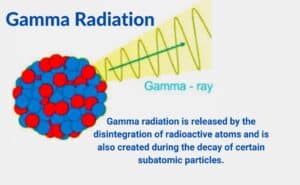Gamma radiation, a form of electromagnetic radiation, has intrigued scientists for decades due to its deeply penetrating nature and its various applications in medicine, industry, and research. The question of whether it is possible to create gamma radiation in a laboratory setting is one that deserves meticulous exploration. In this discourse, we shall delve into the mechanisms, techniques, and implications of generating gamma radiation, whilst examining the broader context that surrounds this fascinating subject.
To comprehend the potential for gamma radiation generation, it is imperative to first elucidate what gamma radiation essentially is. Gamma rays are high-energy photons emitted from the nucleus of radioactive atoms. They exhibit no mass or charge, enabling them to traverse materials that would typically obstruct other forms of radiation. This distinctive characteristic renders gamma rays useful in various sectors, from cancer treatment to the sterilization of medical equipment.
In laboratory contexts, the genesis of gamma radiation predominantly relies on the decay of radioactive isotopes or by accelerating charged particles to energies sufficient to instigate the emission of gamma photons. To cultivate a deeper appreciation for these processes, it is prudent to explore the two primary methodologies involved in creating gamma radiation: radioactive decay and nuclear reactions.
Radioactive decay is perhaps the most ubiquitous method for producing gamma radiation. When certain isotopes, such as cobalt-60 or cesium-137, undergo beta or alpha decay, they often transition to a lower energy state by emitting gamma rays. This trait is a natural and spontaneous phenomenon, wherein the unstable nucleus loses energy in the form of gamma radiation. Laboratories equipped with proper shielding and safety protocols can harness such isotopes under stringent regulations to generate gamma rays for diverse applications.
Nuclear reactions provide another avenue for producing gamma radiation. By propelling charged particles (such as protons or alpha particles) at target nuclei, researchers can induce nuclear reactions that culminate in the emission of gamma radiation. A quintessential example of this approach is seen in particle accelerators, which are sophisticated apparatuses designed to accelerate particles to high velocities. The collisions that occur within these devices can result in excitations and subsequent de-excitation of nuclear states, emitting gamma rays as a result.
Yet, the creation of gamma radiation in a lab is not without its challenges and ethical considerations. The use of radioactive materials, for instance, necessitates rigorous safety measures to mitigate the risks of radiation exposure. The handling of such materials requires specialized training, and the disposal of radioactive waste poses a significant environmental concern. Therein lies a moral imperative for researchers and institutions to prioritize safety and responsibility when engaging in experiments that generate nuclear radiation.
In tandem with safety concerns, the potential applications of lab-generated gamma radiation compel noteworthy contemplation. In the realm of medicine, gamma rays hold pivotal roles in both diagnostics and therapeutics. For instance, gamma cameras are deployed in nuclear medicine to visualize radionuclide distribution within the body, facilitating the early detection of diseases. Furthermore, targeted radiation therapy employs gamma rays to localize and obliterate malignant cells in cancer treatment, showcasing the profound impact of this form of radiation in improving patient outcomes.
Additionally, the industrial sector exploits gamma radiation in non-destructive testing. By examining materials and welds for structural integrity, gamma rays enable the identification of hidden flaws without compromising the integrity of the tested object. This application underscores the versatility of gamma radiation, as it transcends mere scientific curiosity to become an invaluable tool in ensuring safety and efficacy across myriad industries.
Moreover, the exploration of gamma radiation extends into the realm of research. The generation of gamma rays facilitates insights into structure and reactions at the subatomic level. Researchers utilize gamma spectroscopy to gain information about the energy levels and transitions of atomic nuclei, thereby augmenting our understanding of fundamental physics and advancing the frontiers of knowledge within various scientific disciplines.
As the discourse on generating gamma radiation within laboratory confines unfolds, it becomes evident that the implications stretch far beyond the immediate technical capabilities. The ethical dimensions surrounding radiation safety, the prioritization of responsible research practices, and the potential societal benefits of gamma rays compel us to reconsider how we perceive this rarefied phenomenon. Rather than viewing gamma radiation solely through a lens of hazard and trepidation, one might contemplate the transformative possibilities it offers across medicine, industry, and academia.
In conclusion, it is unequivocally possible to create gamma radiation in a laboratory setting through the nuanced mechanisms of radioactive decay and particle-induced emissions. The ongoing pursuit of research in this domain continues to unveil the mysteries surrounding gamma rays and their multifarious applications. Consequently, researchers, industry practitioners, and policymakers alike are called to embrace a shift in perspective—one that recognizes not only the latent dangers of gamma radiation but also its remarkable potential to foster innovation and enhance the quality of life. As the scientific community continues to tread this intriguing path, the prospects for harnessing gamma radiation responsibly and effectively are limited only by our ingenuity and ethical foresight.












